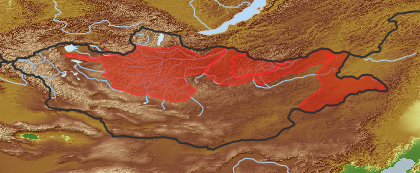| Class: | angiosperms |
| Order: | Rosales |
| Family: | Rosaceae |
| Genus: | Geum |
| Herbar: | list records   |
| open map in a new window |  |
| species: 1 |
| Habit (i)general appearance of a plant | |
| Growth form: (i)Herb, shrub, tree or climber. | herb (i)Herbaceous, erect plant, up to 2m high, mostly with a leafy shoot; if perennial, shoots die to the ground each season, shoots are not woody
example: Artemisia pectinata 
perennial (i)Living for several to many years, as opposed to annual and biennial
|
| Parasite status: (i)Is the plant a half- or full parasite? | no parasite/saprophyte (i)Plant fully autonomous, leaves with chlorophyll
example: Most plants, Ranunculus  inherited by family Rosaceae: no parasite/saprophyte inherited by family Rosaceae: no parasite/saprophyte
|
| Leaf (i)expanded, usually photosynthetic organ of a plant (including phylloclades) | |
| Leaf development: (i)Structure and development of leaves. | with green leaves (i)Plant with green leaves  inherited by family Rosaceae: with green leaves inherited by family Rosaceae: with green leaves
|
| Leaf arrangement: (i)Arrangement of leaves at the stem. | basal rosette (i)Leaves positioned at the base of the stem; stem often without leaves, no visible internodes (but flowers often on erect stems, and these may have few leaves)
example: Limonium, Potentilla, Plantago; also used in Liliales with basaly crouwded leaves (Tofieldia, Zigadenus etc.) 
|
| Stipule: (i)Leaflets at the base of the petiole, these are smaller and of different shape. | pair (i)A pair of free stipulae
example: Lathyrus, Trifolium 
|
| Flower (i)reproductive portion of the plant, consisting of sepals, petals, stamens, and pistils | |
| Flower appearance and pollination: (i)General appearance of the flower. | attractive, animal-pollinated (i)attractive and coloured flowers, mostly large, attracting surely animals
example: Trollius, Rosa, Chamaerhodos  inherited by family Rosaceae: attractive, animal-pollinated inherited by family Rosaceae: attractive, animal-pollinated
|
| Perianth arrangement: (i)Attention: in some plants, flowers may be dimorphic in different ways (dioecious or gynodioecious). If flowers vary, record the characters of the most showy flowers. | double, different (i)Two types of perianth leaves, differently coloured (sepals: outer periant leaves, usually greenish, and petals: inner perianth leaves, usually coloured)
example: Parnassia  
|
| Flower symmetry: (i)Symmetry of the perianth leaves. Attention: to assess this character, look on sepals, petals and stamens, but neglect carpels and ovary. | radiary, regular (actinomorphic) (i)More than two axis of symmetry
example: Saxifraga: 5; Iris: 3   inherited by family Rosaceae: radiary, regular (actinomorphic) inherited by family Rosaceae: radiary, regular (actinomorphic)
|
| Flower form: (i)common forms of flowers ? Veronica | simple (flat) - Do not confuse with inflorescences as in some Asteraceae (i)Petals spread out, flower appearing flat
example: Mollugo, Trientalis, Pulsatilla, Saxifraga   inherited by family Rosaceae: simple (flat) - Do not confuse with inflorescences as in some Asteraceae inherited by family Rosaceae: simple (flat) - Do not confuse with inflorescences as in some Asteraceae
|
| Petal / Tepal number: (i)Number of petal leaves (inner perianth leaves, usually coloured). | 5 (i)
example: Potentilla
|
| Petal / Tepal fusion: (i)To which degree are the petal leaves connected? Petals sympetalous. | free (i)all petal leaves separate from each other
example: Anthriscus  inherited by family Rosaceae: free inherited by family Rosaceae: free
|
| Spur: (i)A hollow, slender, sac-like appendage of the perianth leaves, storing nectar. | no spur (i)Flower without appendage
example: Peganum  inherited by family Rosaceae: no spur inherited by family Rosaceae: no spur
|
| Stamen fusion: (i)To which degree are the stamens fused? Attention: Whereas the pollen sacs itself are often free., their stalks (filaments) may be fused. Here, we count them as fused if they are together over at least one thirth of their length. | free (i)Stamens with separate bases
example: Malus  inherited by family Rosaceae: free inherited by family Rosaceae: free
|
| Carpel fusion: (i)To which degree are the carpels (modified leaf forming simple pistil or part of a compound pistil) fused. | free (i)Carpels entirely free
example: Geum, Aconitum
|
| Inflorescence (i)flowering part of a plant, describes the arrangement of the flowers on the flowering axis | |
| Inflorescence: (i)Structure of the inflorescence. | Solitary flowers (i)Each flower grows on an own leafy stem there may be more than one, if the plant has many leafy shoots
example: Viola, Saxifraga hirculus, Rubus arcticus
|
| Fruit (i)the seed bearing organ, with or without adnate parts; a ripened ovary and any other structures which are attached and ripen with it. Aggregate fruits are handled like simple fruits for determination. | |
| Type of fruit: (i)Common fruit types (including pseudocarp). | Indehiscent fruits
Solitary fruits (i)   
achene (i)A small, dry, indehiscent fruit with a single seed
example: Asteraceae, Apiaceae (schizocarp), Dipsacaceae, Rosaceae, Ranunculaceae  
nut or nutlet (i)Dry fruit with a single, hard stone inside (and usually a large often edible embryo) 
|
| Root / shoot below ground (i)plant part below ground (in most cases), including below ground shoots, without leaves | |
| Root type: (i)Organisation of the roots. | allorhizous (i)Plant with a conspicuous tap root, one larger tap root with side roots
example: Dicotyledonae  inherited by order Rosales: allorhizous inherited by order Rosales: allorhizous
|